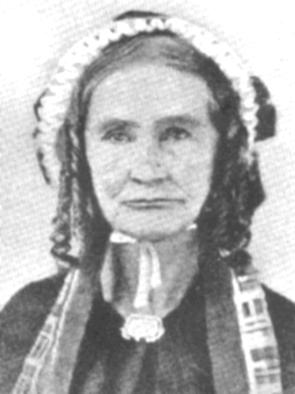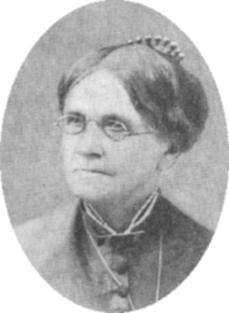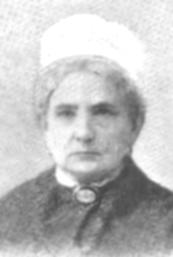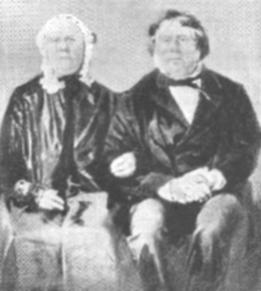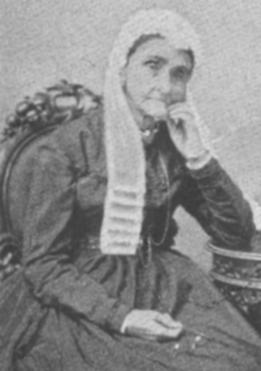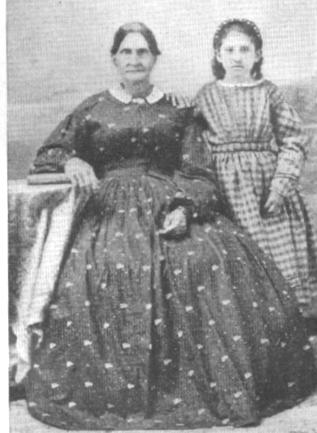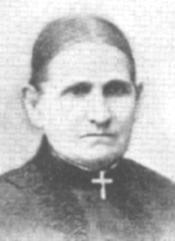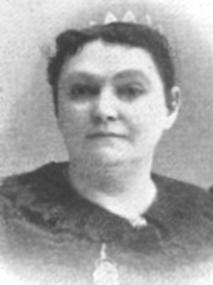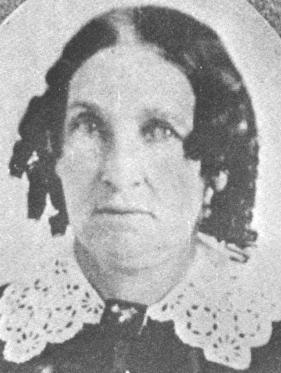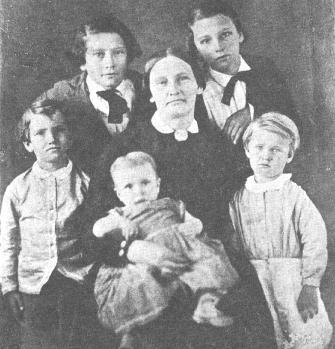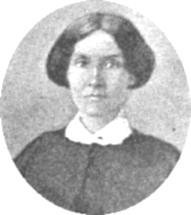SONS OF DEWITT COLONY TEXAS DeWitt Colony Ladies | Alamo Widows & Mothers THE WOMEN OF PIONEER DAYS "....men are animated by love of adventure, desire for wealth or fame....female pioneers are sustained alone by the strength of their devotion to others." The general character of women who willingly venture into unexplored wilds finds illustration in the lives of a few deservedly famed in the early annals of Texas. While men are animated by love of adventure, desire for wealth or fame, which convert every obstacle overcome into a glorious triumph, female pioneers are sustained alone by the strength of their devotion to others, and weak hands learn to perform labors, and tender hearts to bear trials, unendurable by the sterner sex, and which in less perilous times would have been impossible, even themselves. There are places on the Texas coast where women displayed fortitude and endured hardships illustrative of the wonderful depths of conjugal love, the great capacity for calmly awaiting a hoped-for result in the midst of untold dangers, which belong alone to noble souls, to capacious minds. It requires far less strength of character to face visible danger than to dwell calmly where it is known to be near, but keeps partially veiled. Chronicles of the first occupancy of Texas by families from the "States" abound with tales of perilous sea-voyages followed by shipwrecks on the sandy shores; then even greater hardships ensued, scarcity of food, exposure to the elements before suitable habitations could be provided, attended by dangerous illnesses and deaths, not to mention the always dreaded and too often realized terrors of attacks by savage Indians. The Carancahuas on the coast, almost amphibious in their habits, were as likely to approach a lonely habitation by water as by land, and their reputation as cannibals made them even more dreaded than the tribes of the interior.
Tales of shipwreck and first arrivals. Few women came to Texas before the establishment of the first colony, when numbers settling in a specified locality greatly lessened the dangers, and banished that feeling of utter loneliness unbearable by women except those possessed of the strongest natures. Among these few, the experience of one, the wife of Dr. Johnson Hunter, will be taken as a type. According to family records, in the year 1822 she, with her husband and five children, one an infant in arms, was cast ashore on Galveston Island. Amid dangers and difficulties inseparable from such an accident at such a period of time, repairing the wrecked vessel, they reached Morgan's Point, where she assisted her husband in making a home, one of the first on Galveston Bay. There, with the camp-fires of the Carancahua Indians at Red Bluff, about seven mile, distant, in sight on one side of her, and a boundless uninhabited region on the other, she possessed her soul with that composure born of necessity which comes to those who feel that courage must be theirs in order to inspire it in younger hearts. On one occasion, her husband, being necessarily absent for some days, left as a protector a worthy old man named Brown, who in a few days fell sick and died. Without neighbors, without help to prepare a coffin or dig a grave, Mrs. Hunter felt, as never before, the extreme isolation and desolateness of her situation. Wrapping the body in a counterpane, she, with her little children, prayed that a kind Providence might send aid in this dire hour of need. Truly, an answer to her prayers seems to have been granted, for on the second day two men rode up and dismounted; the touching tale of the unburied man told by the anxious, almost unnerved woman appealed to one of the strongest instincts of humanity, and the hitherto light-hearted travelers assumed the unwanted roles of undertakers and grave-diggers. Thus did that sternest of teachers, necessity, adapt unskilled hands to the performance of varied tasks, and thus were the women of those times subjected to anxieties which from their very nature would be impossible in older communities. The keenest suffering of these women was always for others, for the safety of husbands, fathers, brothers, and children, whose manner of living involved the daily risk of their lives, for, in the first years, game must be won from the forest and prairie, else the family would be without meat. Except the fish from the rivers and bays, the country afforded nothing else palatable to the white race.
Every imported article was taxed at a very high rate, which compelled the use of home-made articles; wagons were constructed entirely of wood; the wheels consisted of traverse sections cut from the trunk of large trees, and in all cases as little iron was used as possible; sleds were also in common use. Yet sometimes handsome articles of furniture and sets of fine china were to be seen, the latter ranged on shelves around the best room, and often the only one. Every house was open to travelers, and there was seldom a time when some sojourner from the outside world was not temporarily a member of the household; in summer the gallery or passage afforded good enough lodging for a traveler who carried his own bedding (a couple of blankets tied behind his saddle), but in cold weather a room for their accommodation was called the "men's room," where, seated around a blazing log-fire, tales were told of marvelous adventure, of hair-breadth escapes from wild beasts and Indians, interspersed with the always interesting political news brought by the latest arrival from the United States. In some instances houses were built for defense in the style known as block-houses, one or two logs near the eaves being perforated with port-holes or omitted entirely, and the walls for a space of two or three logs near the top were made to slope outward, so that persons crouching behind them could discharge their shots immediately upon assailants who might venture close enough to attack or set fire to the house. In the more thickly-settled colonies danger from Indians was comparatively slight; but where single families were scattered over large areas, the nearest neighbors many miles away, the gloom of night was increased by dread of the Indians' tomahawk and torch. Careful women so situated usually slept in dark-colored gowns, and never retired without making provisions for escape should danger threaten, by having a loose puncheon or board in the floor, leaving space sufficient for a person to pass p through and lie or crawl under the house until the danger had passed or favorable opportunity offered for seeking shelter in thicket or tall prairie grass. Courage and great presence of mind were continually brought into play on the part of the women, the daily absence of the men in the field, in the chase, and on necessary journeys to meet business engagements rendering these qualities of prime necessity. Many are the instances recorded where the lives of the family were saved by their exercise, and when they were wanting or brought into action too late bloodshed and captivity often resulted. The breadth of a woman's duties, interaction with slaves and homespun clothes. The duties devolving upon a woman of colonial days in Texas were more numerous and care-compelling than can readily be conceived. Besides the ordinary responsibilities, such as every mistress of a household experiences, hers were multiplied a hundred-fold. The ownership of slaves, of which there were many in the colony, I while perhaps lessening the amount of hard labor which might otherwise have been her share, in itself greatly increased her responsibility. Their houses were situated at a considerable distance from that of the family, the kitchen often fifty or a hundred feet distant, and, unless a separate room near the kitchen was built for a dining-room, the hall-way in the main house was used for that purpose, and a retinue of little and large servants was kept constantly passing to and fro at meal-times. The mistress presided over the coffee-cups at table and directed the movements of the small waiters, some of whom were always in training. Foreign travelers have, commented upon the absolute silence upon general topics of conversation which characterized the custodians of the coffee-cups, forgetting that the almost universal presence of strangers and the great preponderance of men at the table engendered habit of modest reticence which in no way impaired their conversational powers when circumstances favored. An enumeration of the manifold daily tasks which engaged the attention of the presiding genius of a colonial household conveys a reproach to the busiest women of today. In the first place, the clothing for whites and blacks was mostly of homespun, the whir of the spinning-wheel, the beating of the loom, and the click of the knitting-needles were as common as in the first colonies on the Atlantic coast. All the clothing was made at home, from the coats and pants of the master, usually dyed a rich brown with the bark of the black walnut, to the white and blue cottonades of the slaves. Buckskin suits, consisting of pants and overshirt trimmed with cut fringes of the same material, were much in vogue, and moccasins were usually worn, brogans or top-boots being rarely obtainable. Even when the possession of a competent Negro seamstress relieved the mistress of much sewing, she at least did most of the cutting out and directed all the work. Coarse blankets were made into over coats. The stripes at the ends ran across the shoulders and ornamented the lapels, a good matching of stripes being considered the test of skill in a sewing-woman. Blankets with a slit in the middle and faced to prevent raveling were worn in the style of the ornamental and expensive Mexican blankets, which, on account of their cost, were owned only by a few. Homemade hats of braided palmetto were common, as were also caps of coon- or rabbit-skins or other peltries. The ordinary equipment of a man for a journey was a good pony, Mexican saddle, bridle and rope made of horse-hair, the latter tied to the saddle-bow, homespun wallet containing panola, or cold flour, which consisted of parched corn ground in a steel mill and flavored with sugar and spices, ground coffee, a tin cup, two bottle gourds filled with water, one or two blankets rolled and tied behind the saddle, a hunting knife, flint and steel, home-molded bullets, a shot-pouch and powder-horn suspended from the person, and a gun, usually a rifle, laid before him. Whatever meat he needed he expected to kill, and the panola mixed with water furnished a most nutritious and palatable substitute for bread. All these little details of equipment were matters of careful attention on the part of the housewife, and in cases of alarm on account of threatened invasion or incursions of hostile Indians, while her hands were very full her heart was very heavy. Sickness incident to the unaccustomed manner of living and acclimatization made it necessary for the women to acquaint themselves with the natural remedies afforded by vegetation. Doctors were not to be had by telephone, and distances were too great to permit of a messenger being despatched for the one physician of a neighborhood, except in very serious cases. Besides the family and slaves, there was frequently the stranger within the gate to be nursed back to health, or the wounds inflicted by Indian arrows or other casualty to be healed. Not only was the colonial woman mother, housekeeper, weaver, tailor, dressmaker, seamstress, apothecary, doctor, nurse, but sometimes, in case of prolonged illness or death of her husband, she became the overseer of farm-work as well. As was natural with families of good social standing and education, and there were but few others, the need of schools was pre-eminent in their minds, and many a good scholar who came to Texas with no in intention of teaching was pressed into service by the importunities of his neighbors. A schoolhouse erected in a neighborhood was made large enough to accommodate not only all the children within riding distance, but many others from less favored or less thickly-settled sections were received into families, often without thought of requiring or accepting payment for board, and were taken care of by the good women as their own. In the coast country the names of Wilbarger, Henry Smith (afterwards provisional governor), Phineas Smith, Thomas J. Pilgrim, Mr. Nona, J. W. Cloud, and Mr. Copeland are still cherished by a few of their surviving pupils. The first young ladies' boarding-school was opened by Miss Track, of Boston, at Cole's Settlement, in January, 1834.
Maturity and reliability of Texian children. Children never trained to habits of close observation and self-reliance; boys of fourteen, or even younger, were often sent alone on important errands distances requiring several days' journey on horseback. After the camp-fire had served its purpose, prudence taught them to leave it a mile or more distant before lying down to sleep, in order to mislead Indians who might have been attracted by the smoke or light. It often became the duty of the boys at school to mount their ponies and accompany their elders in pursuit of bands of Indians. A notable instance occurred at Rutersville College soon after the opening of the school. Two young boys in the neighborhood while hunting horses were attacked by Indians, and one of them, Henry Earthman, was killed; his brother Fields escaped and brought the news to the school. The excited boys joined in the search for the body, which lay a mile away in a dreadfully mutilated state. The scalp had been taken, the hands cut off and thrown into the grass, and the heart, with ligaments unsevered, laid on one side of the body; it was found to have a bullet in the centre, and was, no doubt, exposed in a spirit of bravado to show how unerring was the aim of the red man. Nearly all the boys in the school, ranging in age from fourteen to sixteen, joined in the pursuit of the Indians, which lasted about three weeks. In fact, one of them still living says they did little but hunt Indians while at school at Rutersville prior to 1842. The daily fare. Privations experienced by families living in the interior were far greater than those on the coast after the first dangers from Carancahuas were dispelled; opportunities for procuring groceries and other comforts, or even luxuries, occasionally offered; but where transportation by pack-mules was the rule, flour was almost unknown. Children three or four years old have been known to receive a biscuit as a plaything, accepting with apparent incredulity the assurance that it was good to eat. In times of scarcity of corn, venison took the place of bread, and wild turkey or buffalo furnished the supply of meat. But, however scanty the supply of food, no traveler was denied admission to the family board; the long-handled gourd, with the bucket of water, stood on a shelf at the front door, and the coffee-pot was always on the hearth, ready at a moment's notice to refresh the wayfarer. Mail service and communications. There was no regular mail service until after the organization of the government in 1836, and it was for years very imperfect and irregular. Letters were carried by travelers, and those from the outside world were months old before they reached their destination. Newspapers were rare and were read with intense interest, and it was considered a wonderful improvement in the mail facilities when, as late as in the "forties," regular communications once a fortnight were established by Captain Wright, with the old steamer Columbia, between Galveston and New Orleans. Letters from the colonies contained pretty faithful records of daily events, and those written by Mrs. Mary Austin Holley, cousin of S. F. Austin, were published in 1831 in a book, with a map of the colony, constituting the first History of Texas in English. While dangers continually lowered over the colonists, they by no means surrendered themselves to gloomy forebodings, but rather enjoyed in the fullest measure such pleasures as belong to the young and buoyant. Optimism and value of festivals. The very exuberance of nature's beauties bade them be merry; the prairies were carpeted with flowers, the forests festooned with garlands; all seemed to invite the celebration of May-days as in the old homes, when youth and fair nature meet the rapture is mutual. When balls were given in social centres, the stately magnolias, the fragrant yellow jessamines, yielded their blooms for decoration, or, in default of flowers, the cedars were wrought into graceful designs. The refinements of society were not neglected amid nature's wildness, but the latter seemed rather to stimulate their exercise. The flower plucked from the edge of a precipice is more prized than that which grows in a garden, and so the very dangers which surrounded the early Texans made the enjoyment of social pleasures more intense. Dances were frequent, for in most neighborhoods a violinist was present, and grand balls were given to celebrate the arrival of noted visitors, people willingly travelling fifty and even a hundred miles on horseback to attend them. At the very beginning of the Revolution, in June, 1835, when the imprisonment of peaceful citizens by Captain Tenorio at Anahuac caused Travis to send him and his forty Mexicans packing, they stopped at Harrisburg on their way to San Felipe, and the officers attended a dance which happened to be in progress. Little did the young ladies who danced with the dashing captain realize the gravity of the political situation. A few months, afterwards the little town was bristling with military preparations, and the women were busy cutting up their woolen garments for making cartridges, molding bullets, and making and filling knapsacks for the company preparing to march to the west. Mrs. Sarah Rudolph Dodson, whose husband, A. B. Dodson, was first lieutenant in the company commanded by Captain Andrew Robinson, designed and made a flag different from any that had ever floated over an army. It was made of calico; the three colors-red, white, and blue-were cut of equal sizes, square in shape; a five-pointed star, copied from an old military button, was placed in the centre of the blue square, which was fastened next to the flag-staff, the white square next, and then the red, making an attractive banner, and one which with little alteration was afterwards adopted by the government of the republic. This flag was presented early in the fall of 1835, and was carried by the company through the campaign which resulted in the capture of San Antonio. (Details of the design of the flag and of its presentation were obtained from the husband of Mrs. Dodson, to whom she was married in May, 1835, but a few months before its presentation. He is still, March 2, 1896, living at Alice, in Nueces County.)
When at length it became known that the Mexican army had crossed the Brazos River, and that the Texans were retreating towards the Sabine, it was deemed advisable for the members of the cabinet to run to avoid unnecessary risk of capture; so they went on board a schooner, which conveyed them to New Washington at the same time that Mrs. Harris and her servants, Mrs. Westover, and Mr. Batterson's family took passage for Anahuac. Mrs. Westover's husband had been killed with Fannin at Goliad, and she, attended by a single Mexican servant, had fled on horseback from her isolated home at San Patricio and arrived at Harrisburg a short time before, exhausted in strength and with little clothing except what she wore. The march of the invading Mexican army was everywhere preceded by the flight of the entire population, as, from the events at the Alamo and Goliad, death seemed the only other alternative, and this general movement was afterwards, and even until now among old Texans, called the "Runaway Scrape." It was during the "Runaway Scrape" that Mrs. Laura Harrison Jack, wife of William Houston Jack, made the acquaintance of Mrs. J. W. Fannin, whose husband's cruel fate had excited the sympathy and indignation of the civilized world wherever the news of the massacre had extended. Deeply touched by her melancholy state, Mrs. Jack asked her to share her home, and bestowed upon her as many kind attentions as if some tie of kinship had existed. Under her roof a few months afterwards the child, Minerva, was born, whose clouded intellect was but a deepened shade of the poor mother's gloom, and there Mrs. Fannin soon completed the short term of her sorrowful life. In early days at San Felipe, Mrs. Jack was one of the few whose strong religious conviction caused her to refuse compliance with the Mexican law in regard to the Roman Catholic baptism and marriage ceremonial. Her strength of character was only equaled by her personal beauty, which, with other attractive qualities, made her greatly beloved. The trials of the women of the Revolution reached their climax in the "Runaway Scrape" But the return after the runaway was in most instances fraught with even more discomfort than the first establishment of homes had been, for everything had been literally swept away by marauders. Many homes that had been comfortably furnished were utterly bare, and the former occupants were reduced to the necessity of manufacturing their own bedsteads with one post in the corners of the rooms. In many instances, as at Harrisburg and San Felipe, every house had been destroyed by the torch. But the horizon was so brilliant with national glory that personal discomfort was cheerfully endured; homes were desolate, but the "sun of liberty and independence arose in Texas" with the victory at San Jacinto, and personal griefs were put aside in the general rejoicing.
Sentry against military coup against President Burnet---Mrs. Hannah Este Burnet. One of the brave women who had experienced all the dangers and privations of colonial life since 1830 was called upon during this summer, 1836, to undergo the most trying ordeal of all. This was the wife of President David G. Burnet. While the seat of government was at Velasco, the troops, especially some of those who had arrived after the decisive battle, were indignant at the alleged leniency with which President Burnet treated the prisoner Santa Anna; the life of the former was threatened because he refused to yield up the latter to the military. Realizing the serious danger, Mrs. Burnet, who sustained and encouraged her husband in his humane policy, kept nightly watch for weeks with pistols by her side, while her husband enjoyed the needed rest which his exciting position required; thus proving the fine moral fiber of a character which fitted her to be the mate of the stern, noble, old patriot, David G. Burnet. Soon afterwards the prisoner was sent to Orazimbo, the plantation of Dr. J. A. E. Phelps for safe-keeping. Here, though comfortably housed, he was overcome by despondency and attempted suicide by an overdose of opium. The doctor's prompt medical attention prevented fatal consequences, and the kind attentions of his wife made a deep and lasting impression upon Santa Anna. Of this he gave proof when their son Orlando was a Mier prisoner in the City of Mexico, he testified his gratitude by releasing and otherwise befriending him.
Mrs. Augustus Chapman Allen [Charlotte Baldwin], who has but lately passed away at the age of ninety, was also a pioneer at Nacogdoches, whence she removed to Houston, which place she had the honor of naming when first laid out by her husband and brother-in-law in 1836. She was a prominent figure in the social life of this city while it was the capital, and until the weakness of extreme old age compelled her withdrawal from active participation.
"Captain Lysander Wells about this time passed by riding on Soledad Street. He was mounted on a gayly- caparisoned Mexican horse with a silver-mounted saddle and bridle, which outfit he had secured to take back to his native State on a visit to his mother. As he reached the Veramendi House, an Indian, who had escaped detection, rushed out of his hiding-place and, jumping upon the horse behind Wells, clasped his arms and tried to catch hold of the bridle-reins. The two men struggled some time, bent backward and forward and swayed from side to side, until at last Wells managed to hold the Indian's arms with his right hand, and with his left to draw his pistol from the holster. He turned partly round, placed the pistol against the Indian's body and fired, a moment more and the Indian rolled off and dropped dead to the ground. Wells put spurs to his horse and did good service in the pursuit. I had become so fascinated with this struggle that I had unconsciously gone into the middle of the street, when Lieutenant Chevalier, who was passing, called out to me, 'Are you crazy? Go in, or you'll all be killed.' I obeyed; but my curiosity and anxiety again got the better of me, and I peeped out on Commerce Street, where I saw the dead bodies of four or five Indians." Mrs. Isabella Haddon Hopkins (Ibbie) Clark Gordon. Examples might be multiplied of the tragedies witnessed and experienced by the women of those times, the records of Gonzales, Goliad, Bastrop, Austin, and all the frontier settlements of the southern and western parts of the State contributing a share. How many sleepless nights were spent by the lonely women left by circumstances in isolated homes, in listening to the stealthy tread of the moccasined feet of marauding Indians, will never be known, and lucky was the dawn which brought the discovery of no greater loss than that of horses or other property. It is much to be regretted that no records of the experiences of Mrs. Ibbie Gordon of Clarksville, could be obtained. This noble woman died at the age of ninety years, on May 31, 1895. She was one of the earliest settlers in what is now Red River County, and at the time of her death was the oldest living pioneer in that region, having resided there since the year 1823. She was born in Kentucky, her maiden name being Isabella Haddon Hopkins, and her parents were themselves of pioneer stock and heroic experiences. They moved to Texas and settled at the mouth of Mill Creek on Red River. Isabella was first married to John Hanks, in 1824, and was twice married afterwards, her second husband being James Clark, after whom the town of Clarksville was named, and their children, Dr. Patrick B. Clark and Hon. James Clark, are among the most honored and influential citizens of Red River County. Her last husband was Dr. George Gordon, and she has been known to most of the present generation of Texans as Mrs. or Aunt Ibbie Gordon. In 1832, when General Sam Houston visited Texas in company with several others, he stopped at her home for his first night in Texas, she being then Mrs. Clark. During the struggle for independence she equipped and sent forward at her own expense a large number of recruits for the Texan army, and this was but the beginning of many acts of patriotic zeal and large-souled benevolence for which her whole life was noted. Possessed of ample means, her home was the hospitable resort of all the prominent men of early days in Texas, while throughout her life she was distinguished for deeds of public and private generosity and kindness. Like all the women of the colonial and revolutionary times, her experiences in the wilderness of that day were vivid and sometimes tragic, and had she left a record of her many heroic sacrifices, thrilling adventures, and intimate acquaintance with the men and events of our early history, it would have furnished a most valuable contribution to the literature of that interesting era in our development. It is to be hoped that even yet some of the more valuable recollections of her long and remarkable life may be rescued from total loss by the aid of her surviving relatives and friends. International recognition, cultural and social life in the Republic. After the independence of the republic was acknowledged by the United States an impetus was given to immigration, and the invitation to free trade brought many ships bearing foreign flags into the ports. With the establishment of commercial relations with European countries fine goods were imported, and luxuries thus obtained had a hundred-fold value to those who had been long deprived of them, and many of whom in fact had never seen them. Immigration agents from France and Germany sought out favorable locations for colonies. One of the French agents, Snider de Pelegrini, established a business, and on January 1, 1843, gave a ball at Harrisburg, which was noted in all the country round for the elegance of its appointments and the toothsome French confections and fine wines furnished by the generous host. The city of Houston, which was the capital from 1837 to 1840, became the social and political centre of the new republic, and the presence of representatives of foreign countries lent dignity and brilliancy to state occasions, which had been wanting in the colonial assemblies. Social events were marked by whatever of elegance in style was practicable in a new country. The battle of San Jacinto was from the first observed as an anniversary, and its celebration by a ball at Houston on April 21, 1837, was an event of great social importance, and was given in a large, half-finished, two-story frame building on the south side of Franklin Street, near Main. On the completion of the capitol the next year, a ball was given in the Senate chamber. Dresses elegant in texture and design, comprising velvets, satins, laces, and mulls, were worn by ladies whose grace and beauty would have been admired in any assembly. The presence of all of the officers of the government, the eclat attending their recent military achievements, and the courtliness of manner which distinguished them, rendered this and similar entertainments occasions for refined enjoyment, which were highly appreciated. Ladies and gentlemen, accompanied by their retinue of colored servants, came in parties on horseback fifty and sixty miles. Brazoria, Columbia, San Felipe, Harrisburg, Lynchburg, Richmond, and Washington, all places of importance at that time, besides all the surrounding country, were represented. The ball tickets were printed on white satin, and a description of the San Jacinto ball, written by a participant, attests that it was marked by refinement becoming a society largely composed not only of good families but of many who bore names of distinction in their former homes. The music of violins, bass-viol, and fife heralded the grand entry with the air "Hail to the Chief," and General Houston accompanied by one of the most distinguished ladies led the march. The following account of General Houston's evening dress was obtained from the same authority: "Being the President elect, he was of course the hero of the day, and his dress on this occasion was unique and somewhat striking his ruffled shirt, scarlet cashmere waistcoat, and suit of black silk velvet, corded with gold, was admirably adapted to set off his fine, tall figure; his boots, with short red tops, were laced and folded down in such a way as to reach but little above the ankles, and were finished at the heels with silver spurs. The spurs were, of course, quite a useless ornament, but they were in those days so commonly worn as to seem almost a part of the boots. The weakness of General Houston's ankle, resulting from his wound, was his reason for substituting boots for the slippers then universally worn by gentlemen for dancing."
The new nation attracted scientists of distinction. In 1837, Audubon, the great naturalist, visited the capital. Mr. F. Roemer, an eminent German geologist and botanist, came a few years later, in 1845, and penetrated far into the interior. Mr. and Mrs. Houston, of England, sailed in their own yacht as far as Galveston in 1845, and proceeded thence in a steamboat to Houston. They were attracted merely by the desire to see a country with whose fame the whole civilized world was ringing. All have left records of their visits, and with one accord they expressed surprise and satisfaction at meeting people of such liberal culture in the midst of rude surroundings. With the removal of the capital to Austin, circumstances were not so favorable to social pleasure, but even in the midst of the primeval wildness and savage neighbors which surrounded the chosen seat of government, the same round of gayety prevailed. The one-storied capitol, enclosed by a stockade, was often the scene of festive gatherings, and the Senate-chamber reflected the taste of the ladies in the beautiful decorations of mountain flowers, swords, and flags which adorned its walls on such occasions. The two-storied mansion occupied by President Lamar was thrown open for levees, although there was no Mrs. Lamar to preside. A greater number of representatives from foreign lands rendered the society here, if anything, more distinguished by courtly graces. In 1842, the threatened invasion by Mexico caused the transfer of government officials to Washington on the Brazos. Houston again presided over affairs of state, and his accomplished wife with dignified grace, and assisted by the wives of officers of state and other ladies of the town and neighborhood, formed a coterie rich in the traits which not only ennoble womanhood, but attest the cultivation of a people. The second administration of General Houston gave way in 1844 to that of Anson Jones, during which the ultimate destiny of the young nation finally culminated. Again the hill-crowned, mountain-begirt capital became the centre of national life, and the scene of the merging of the Lone Star, with all the national associations clustering round it, into the brilliant galaxy of a kindred government. A description of this event as written and read by Mrs. Jane Gray, widow of judge Peter W. Gray, at a celebration of the anniversary of Texan independence, on March 2, 1893, in the city of Houston, reveals the love borne by old Texans to the republic, and their regret at seeing it pass away. As the patriotic expression of one who gave a long life to the social, intellectual, and religious advancement of the republic and the State, it closes this record--- The day we celebrate, dear ladies, is a birthday, that of a fair princely maiden, whom I will call a republican queen if I may be permitted to do so. Her birth was hailed with joy, not only by the United States but by the leading powers of Europe. England, France, Belgium, and Holland sent their greetings, and in the form of treaties recognized her independence and power. I can never forget one pleasure given me in my girlhood, when I was permitted by a friend to hold in my hands and examine the treaties sent by Holland and Belgium. They were folio books of vellum, bound in rich velvet, one in blue and gold, the other in scarlet and silver, each having attached the large seal in gold and silver cases, with tassels and cords. To my inexperienced eyes they were the most gorgeous and precious works of art I had ever seen. Like all young republics, this young maiden was born amid strife and contest, but added to this our maiden was cradled in privation and subjected to trials of every kind. No purple and fine linen for her. Yet amidst all this she could proudly lift up her head among the nations of the earth. She was supported, sustained, and defended by high-born men of culture and refinement, who have left their impress upon her character for all time. Her life was full of thrilling events familiar to some of the ladies present, which events have turned the fate and made the prosperity and advancement of this Western continent. But this high-souled maiden only lived to be ten years old. That was a brilliant and perfect day in winter, still fresh in my memory, when, with a goodly company assembled on the spacious veranda of the log-built capitol at Austin, we saw the Lone Star banner floating once more over our heads. At the close of those momentous ceremonies this banner was gently, by loving hands, pulled down from its staff, and with regretful hearts and tearful eyes we heard the fiat pronounced by his Excellency, President Anson Jones, 'The republic of Texas is no more!' But we, her loyal so-called 'daughters,' will do our best to keep the bright star of her memory shining in the front, and while we live its lustre shall not fade. I feel confident that an overruling Power who controls all events will allow some of us to see a monument erected worthy to perpetuate the memory of those brave heroes who lived and died that this fair maiden might live. Did ever so short a life as hers accomplish a mission so great and wonderful? SONS OF DEWITT COLONY TEXAS |
